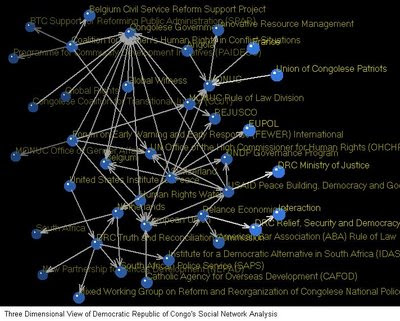Part 1 -- Introduction
Part 2 -- What Makes A Good Method?
Part 3 -- Bayesian Analysis (#5)
Part 4 -- Intelligence Preparation Of The Battlefield/Environment (#4)
Social Network Analysis (SNA) is fundamentally about entities and the relationships between them. As a result, this method has a number of variations within the intelligence community ranging from techniques such as association matrices through link analysis charts right up to the validated mathematical models. It is most commonly used as a way to picture a network, however, and is rarely used in the more formal way envisioned by the sociologists who created the method. In other words, while SNA is a very powerful method, intelligence professionals rarely take advantage of its full potential.
Because it is primarily a visual method, most analysts (and the decisionmakers they support) immediately grasp the value of the method. Likewise, some variation of SNA will likely work with any data set where the entities and the relationships among those entities are important (in other words, almost every problem). Parsing all the relevant attributes can be difficult, however, and there are few automated solutions that work well with unstructured data sets. Likewise, at the higher levels of analysis, where the analyst is trying to do more than merely visualize a network, a good bit of special knowledge is required to understand the results.
Talking about SNA doesn't make a lot of sense though. It is much easier to grasp its value as an intel method by looking at some examples. I2's Analyst Notebook is widely available and examining their case studies is helpful in seeing what that tool can do. Another widely used tool, particularly for more formal analyses, is UCINET. For example, some of our students used this tool last year to examine the "social network" of government and non-governmental organizations engaged in security sector reform in sub-Saharan Africa (the image above comes from their study). Recently, my students and I have been playing around with a new tool from Carnegie Mellon University called ORA. It is very easy to use and very powerful.
Of the 5 methods I intend to discuss, SNA is the one with the widest visibility in all three major intelligence communities (national security, business and law enforcement). As such, there is already a good bit of research activity into how to better use this method in the intelligence analysis process. The big challenge, as I see it, is to design educational programs and tools that help analysts move away from the "pretty picture" possibilities presented by this method and toward the more rigorous results generated by the more formal application of the method.
Tomorrow: #2...
Thursday, December 11, 2008
Top 5 Intelligence Analysis Methods: Social Network Analysis (#3)
Posted by
Kristan J. Wheaton
at
11:37 AM
![]()
Labels: intelligence, intelligence analysis, intelligence methods, list, SNA, social networks
Subscribe to:
Post Comments (Atom)






5 comments:
Having researched and tried some more "formal" SNA, I can say that with only a little knowledge of the theories of SNA, you can greatly improve how much value you get out of the more technical "formal" programs such as UCINET.
The mathematical components can be very helpful to make sense of the sometimes crowded charts that SNA software can produce.
There's a nice set of Social Network Analysis videos on YouTube, at http://www.youtube.com/user/koth55
Krishna Mungur
You may want to look at these SNA projects: 9-11,business cases, criminal networks, terror networks.
You can also consider NodeXL as a free and useful tool to perfom SNA
http://www.codeplex.com/NodeXL
Very good discussion on Social Network Analysis and its sources and method ..and you have described it with the help of beautiful chart which is very interesting.........
Post a Comment